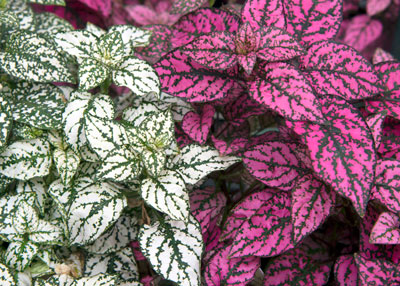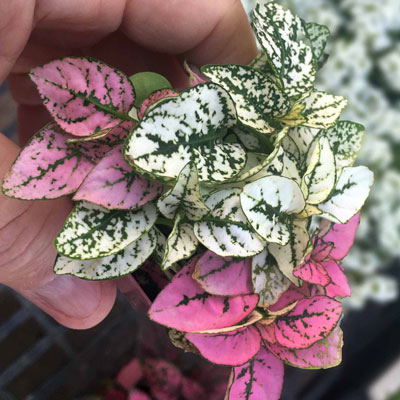Pink Polka Dot Plant

Photo: Two great examples of breeders’ triumphs with this cheerful little tropical beauty.
When I was a kid, I wanted to join the Peace Corps, and I wanted to go to Madagascar. So many of the really odd plants that I loved were from there, and all I could think of was going there to see them in their native habitats. Forget that the Peace Corps was about a grander plan. But that wasn’t to be anyway, so I ended up teaching school, getting married and having a family, working for Extension, and trying out a career in radio and writing – I’ll see if that works out.
But I still like the plants from Madagascar, and this is one of them. Hypoestes phyllostacha, also known as pink polka dot plant. When I saw it in the Texas A&M greenhouses in 1963, it came in plain old basic pink. Not a big seller at the all-male military A&M of that era.
Breeders got busy over the ensuing years and started introducing deeper shades of red, brighter pinks, lavenders and pure whites and this little beauty was on its way.

Photo: Tiny little starter plants began life as “plugs” in a greenhouse. They’re being sold here for terrariums.
Uses and Care…
Polka dot plants grow to be 15 to 18 inches tall and 12 to 15 inches wide. They’re good massed in small groups in beds or in containers with flowers or other contrasting foliage. Grow them in highly organic planting soils that can be kept uniformly moist and fertile. Grow them in morning sun until 9 or 10, then shade the balance of the day.
They respond well to pinching to keep the plants compact, especially to remove flower spikes. As with many plants with showy foliage (coleus, caladiums, lamb’s ear, etc.), the flowers slow production of new leaves and detract from the looks of the plants.
A few gardeners try to carry their polka dot plants over in the house or greenhouse in winter, but most of us soon find that it’s easier just to start with fresh and vigorous new plants each spring.
